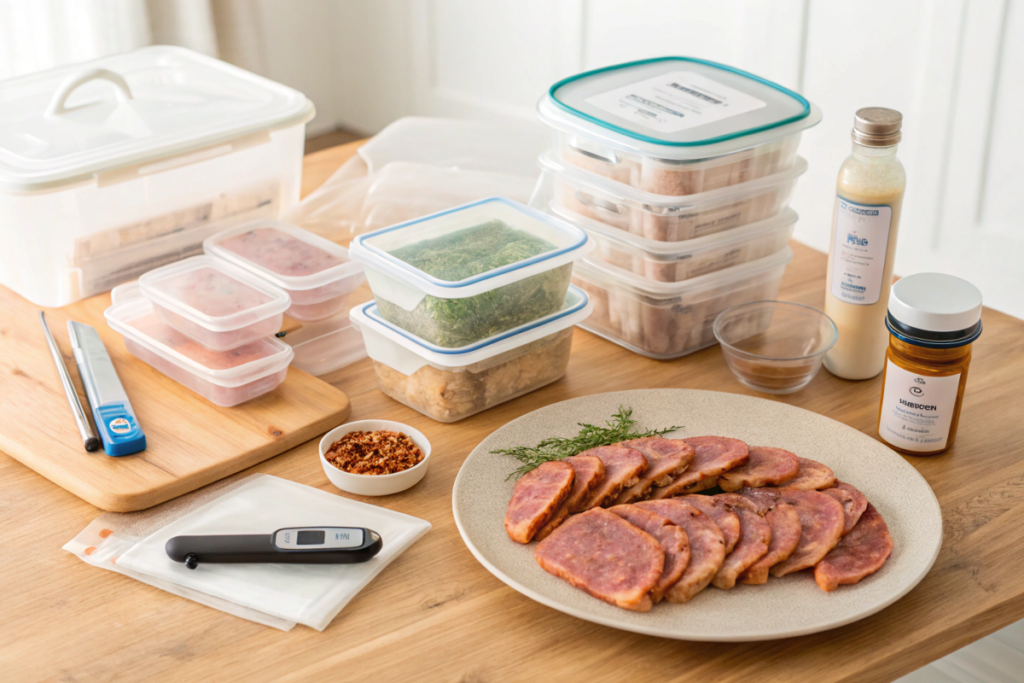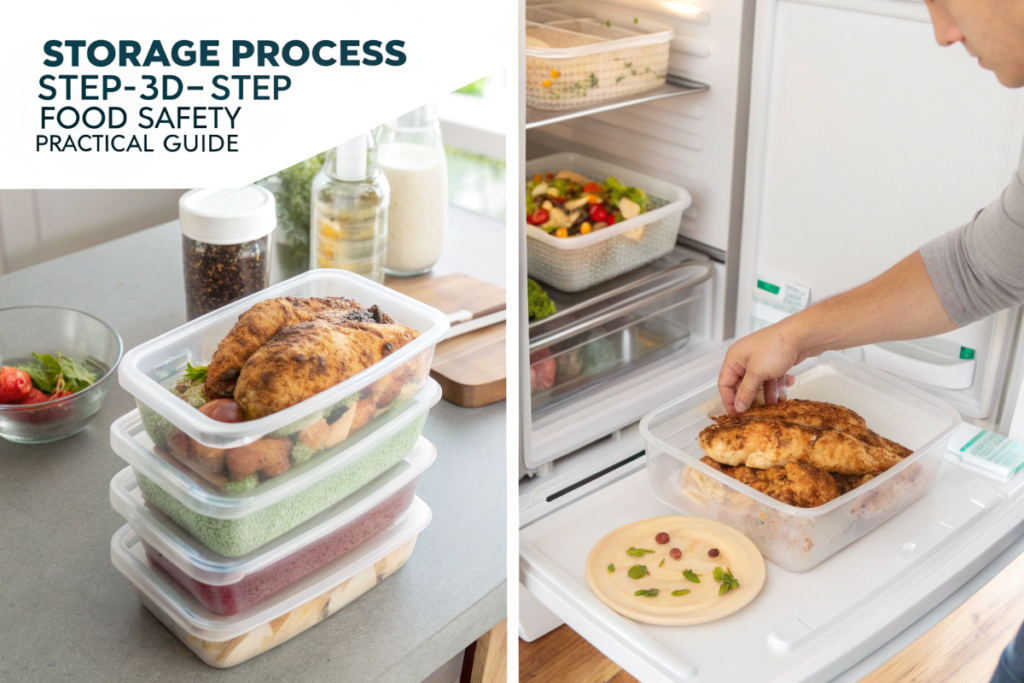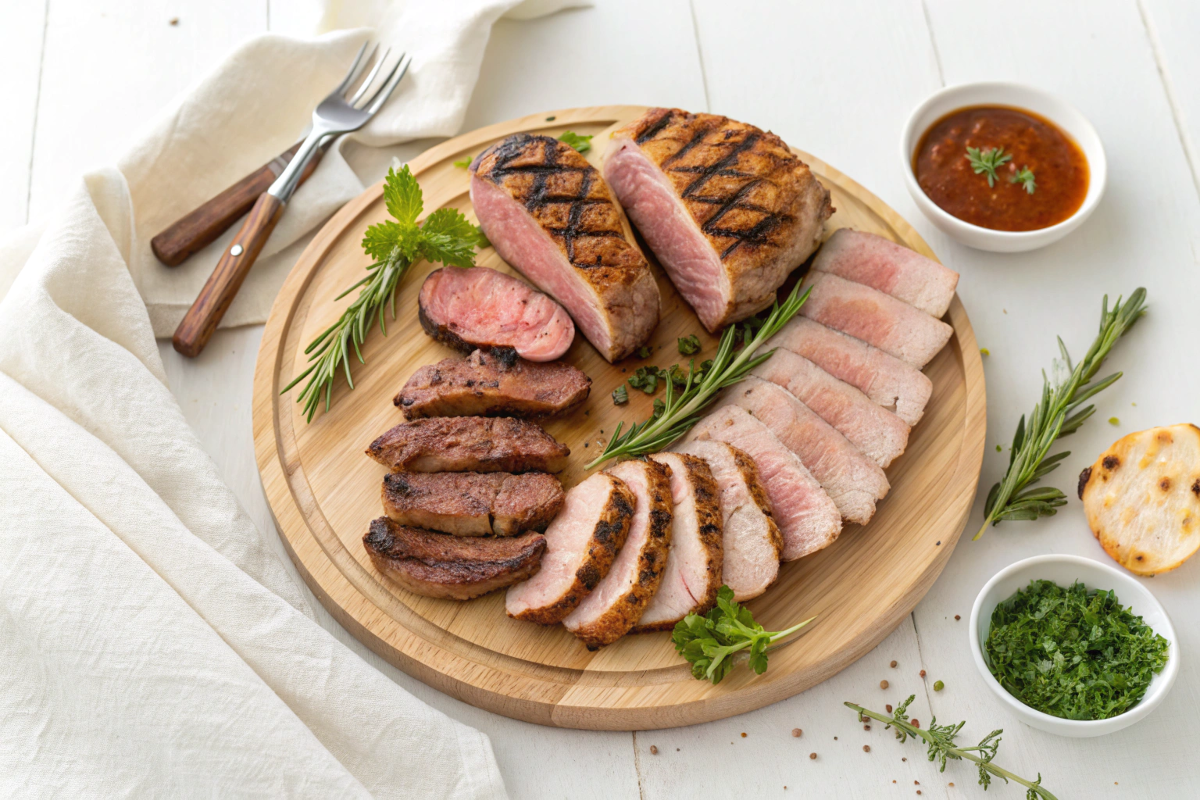Understanding Cooked Meat Storage
Proper storage of cooked meat is essential not only for maintaining its safety but also for preserving its flavor and texture. Furthermore, understanding how long cooked meat is good in the fridge is crucial as it helps prevent foodborne illnesses, reduces waste, and ensures your meals remain delicious. Additionally, for tips on choosing the best meat for special occasions, visit Popular Meat for Christmas Dinner.
Why Proper Storage is Essential
Cooked meat needs to be stored correctly to remain safe and enjoyable. Here’s why it matters:
- Bacterial Growth:
- Harmful bacteria grow quickly when meat stays at unsafe temperatures. For example, leaving meat at room temperature for more than two hours can make it unsafe to eat.
- Quality Preservation:
- Improper storage causes meat to dry out, lose flavor, or develop unpleasant odors. Storing it correctly maintains its taste and texture.
- Food Waste Prevention:
- When meat spoils due to poor storage, it leads to unnecessary waste and increased costs. Proper techniques help avoid this issue.
By understanding these factors, you can ensure cooked meat stays fresh and safe to eat.
Common Types of Cooked Meat
Different types of cooked meat require similar storage practices, but each may have unique considerations.
- Chicken:
- Chicken is versatile and used in various dishes like salads and sandwiches. To store it safely, refrigerate or freeze it within two hours of cooking. This step prevents bacterial growth and preserves its texture.
- Beef:
- Beef, including steak, ground beef, or roasts, stays flavorful and tender when stored properly. Wrapping it tightly or using airtight containers prevents drying out and freezer burn.
- Pork:
- Dishes like pulled pork, ham, or pork chops should be kept in airtight containers. This helps retain their moisture and prevents odor transfer in the fridge or freezer.
- Other Meats:
- Lamb, turkey, and game meats also need proper storage. Wrapping them securely keeps them fresh and avoids contamination.
For all types of meat, cooling and storing them within two hours of cooking minimizes the risk of spoilage and bacteria.
Key Takeaways
Storing cooked meat properly is crucial for ensuring safety, reducing waste, and preserving flavor. By using airtight containers, wrapping the meat securely, and refrigerating it promptly, you can maintain its quality and enjoy your meals with peace of mind.
Ideal Refrigerator Temperature for Storage
Storing cooked meat in the refrigerator at the correct temperature is essential to keep it fresh and safe. Maintaining the right conditions ensures that harmful bacteria cannot grow, preserving the quality and flavor of your food.
Recommended Temperature Settings
The ideal temperature for storing cooked meat in the refrigerator is below 40°F (4°C).
- Why This Matters:
- Bacteria that cause foodborne illnesses, like Salmonella and Listeria, grow rapidly between 40°F (4°C) and 140°F (60°C), a range known as the “danger zone.”
- Keeping the fridge below 40°F slows bacterial growth, extending the shelf life of your cooked meat.
- Best Practices:
- Set the refrigerator to 35°F–38°F (1.5°C–3°C) to provide a buffer and ensure it stays consistently cool, even when the door is opened.
How to Check Fridge Temperature
Ensuring your fridge operates at the correct temperature is crucial for food safety.
- Use a Refrigerator Thermometer:
- Place a thermometer on the middle shelf where the temperature is most stable. Avoid relying solely on the fridge’s built-in settings, as they may not always reflect actual conditions.
- Monitor Regularly:
- Check the temperature at least once a week to ensure it remains within the ideal range.
- If the fridge temperature fluctuates, inspect the door seals for wear or damage, as faulty seals can allow warm air to enter.
- Adjust When Necessary:
- If the temperature is too high, lower the setting on your fridge and check again in a few hours. For older refrigerators, consider servicing or replacing them if they fail to maintain proper cooling.
Proper refrigerator temperature is key to keeping cooked meat safe and fresh. By maintaining the ideal settings and checking regularly, you can ensure your food stays at its best for longer.
General Guidelines for Cooked Meat Storage
Proper storage of cooked meat ensures food safety and maintains its quality. Understanding average storage times and recognizing signs of spoilage can help you avoid foodborne illnesses and reduce waste.
Average Storage Times for Different Meats
Cooked meat remains safe to eat for a limited time when stored in the refrigerator or freezer. Here are general guidelines:
- Chicken and Turkey:
- Refrigerate for up to 3–4 days.
- Freeze for 2–6 months for best quality.
- Beef and Pork:
- Refrigerate for 3–4 days.
- Freeze for 2–6 months, depending on the cut and preparation method.
- Ground Meats (Beef, Turkey, Pork):
- Refrigerate for up to 2 days.
- Freeze for 2–3 months.
- Cured or Processed Meats (Ham, Sausages):
- Refrigerate for 7 days if unopened, or 3–4 days once opened.
- Freeze for up to 2 months.
Always store cooked meat in airtight containers or freezer bags to preserve its freshness and prevent contamination.
Signs of Spoilage
Knowing when cooked meat has gone bad is crucial for food safety. Look for these signs of spoilage:
- Unpleasant Odor:
- Spoiled meat often emits a sour, rancid, or ammonia-like smell.
- Discoloration:
- If the meat develops gray, green, or slimy patches, it should not be consumed.
- Texture Changes:
- Sticky, slimy, or tacky textures indicate spoilage. Fresh meat should feel firm and moist, not overly wet or sticky.
- Mold Growth:
- Visible mold, even in small amounts, is a clear sign that the meat is unsafe to eat.
If you notice any of these signs, discard the meat immediately to avoid potential health risks.
Proper storage and prompt recognition of spoilage ensure that cooked meat remains safe and enjoyable. By following these guidelines, you can minimize waste and protect your family’s health.
Specific Storage Times by Meat Type
Knowing the specific storage times for different types of cooked meat helps ensure safety and maintains their flavor and texture. Proper storage techniques, whether refrigerating or freezing, are crucial to preventing spoilage and foodborne illnesses.
Cooked Chicken
Cooked chicken is a versatile meat, but it has a relatively short shelf life.
- Refrigerator:
- Store cooked chicken in an airtight container for 3–4 days.
- Freezer:
- Freeze chicken in freezer-safe bags or containers for 2–6 months.
Tip: Shred or portion chicken before freezing for easier reheating and meal prep.
Cooked Beef
Cooked beef, whether as steak, ground beef, or roasts, remains fresh with proper storage.
- Refrigerator:
- Refrigerate cooked beef for 3–4 days in sealed containers.
- Freezer:
- Freeze beef for 2–6 months.
- Ground beef lasts 2–3 months in the freezer.
Tip: Label containers with the date to track storage time and avoid waste.
Cooked Pork
Cooked pork, including pulled pork, ham, or chops, requires careful storage to retain its moisture and flavor.
- Refrigerator:
- Refrigerate cooked pork for 3–4 days.
- Freezer:
- Store cooked pork in freezer-safe containers for 2–6 months.
Tip: Wrap pork tightly in foil or freezer wrap to prevent freezer burn.
Cooked Seafood
Cooked seafood is more delicate than other meats and should be consumed quickly.
- Refrigerator:
- Store cooked seafood for 2–3 days in an airtight container.
- Freezer:
- Freeze cooked seafood for 2–3 months, ensuring it is tightly sealed.
Tip: Avoid reheating seafood multiple times, as this can affect its texture and flavor.
Properly storing cooked meats according to their type and recommended timeframes ensures safety and quality. By following these specific guidelines, you can enjoy your meals without worrying about spoilage or waste.
Factors That Influence Meat Freshness
Maintaining the freshness of meat is crucial for both its taste and safety. Several factors come into play when determining how long meat remains fresh and safe to consume. Below are the key factors:
Packaging Methods
The way meat is packaged has a significant impact on its freshness. Vacuum-sealed packaging, for instance, removes oxygen, which helps to slow down the growth of spoilage bacteria. On the other hand, plastic-wrapped meat with ample airflow can lead to quicker spoilage due to exposure to air and moisture. The type of packaging used can also prevent freezer burn and retain the meat’s natural flavor.
Fridge Conditions
Proper refrigeration is essential to extend the shelf life of meat. The ideal temperature for storing raw meat is 32°F to 40°F (0°C to 4°C). Variations in temperature can encourage bacterial growth, especially if the fridge is overcrowded or not functioning efficiently. Additionally, storing meat on the lowest shelf of the fridge in a leak-proof container helps prevent cross-contamination and maintains a consistent environment for freshness.
Timing from Cooking to Refrigeration
The time it takes to refrigerate meat after cooking plays a critical role in its freshness. It’s best to refrigerate cooked meat within two hours of cooking to minimize bacterial growth. For large portions, dividing the meat into smaller, shallow containers allows it to cool quickly, reducing the time spent in the “danger zone” (40°F to 140°F or 4°C to 60°C) where bacteria multiply rapidly.
By understanding and managing these factors, you can ensure that your meat remains fresh for longer periods, preserving both its quality and safety.
Proper Packaging for Cooked Meat
Storing cooked meat properly is crucial to maintain its flavor, texture, and safety. Using the right packaging ensures the meat stays fresh for longer while avoiding common issues like freezer burn.
Best Containers for Storage
Choosing suitable containers for storing cooked meat is essential for preserving its quality.
- Airtight Containers:
- Use sturdy, BPA-free plastic or glass containers with tight lids to prevent air from getting in. These are perfect for refrigerating meat and keeping it fresh for up to four days.
- Additionally, stackable containers save space in the fridge or freezer.
- Freezer Bags:
- Opt for resealable freezer bags that are heavy-duty and designed to resist moisture. Before sealing, squeeze out as much air as possible to reduce exposure to oxygen.
- Moreover, labeling the bags with the date helps you keep track of storage times.
- Aluminum Foil or Plastic Wrap:
- Wrap larger cuts of meat tightly in foil or plastic wrap to lock in moisture. Place them in a freezer-safe bag for added protection.
Using the right containers not only keeps meat fresh but also prevents contamination.
Vacuum Sealing Benefits
Vacuum sealing is an excellent method for preserving cooked meat, as it removes air and extends freshness.
- Advantages of Vacuum Sealing:
- By removing air, it reduces the risk of bacterial growth and freezer burn.
- It also locks in moisture and flavor, ensuring the meat retains its taste and texture.
- Furthermore, vacuum-sealed meat can last up to a week in the fridge and several months in the freezer.
- Ideal for Meal Prep:
- Vacuum sealing works perfectly for storing portioned meat after batch cooking. This makes reheating quicker and more convenient.
Investing in a vacuum sealer is worthwhile for those who regularly store meat.

Tips for Avoiding Freezer Burn
Freezer burn can dry out cooked meat, leading to a tough texture and bland taste. However, simple steps can prevent this issue.
- Wrap Tightly:
- Always wrap meat securely in plastic wrap or foil before placing it in a freezer-safe container.
- Additionally, double-wrapping provides extra protection against air exposure.
- Use Quality Freezer Bags:
- Choose heavy-duty bags that are specifically designed to keep out moisture and air.
- Ensure all the air is squeezed out before sealing to prevent ice crystals from forming.
- Maintain Proper Freezer Temperature:
- Set the freezer at 0°F (-18°C) to keep the meat in optimal conditions.
- Furthermore, avoid opening the freezer frequently to prevent temperature fluctuations.
Rotating your stored meat helps ensure older items are used first, reducing waste and maintaining quality.
Proper packaging plays a vital role in keeping cooked meat fresh and safe. By using airtight containers, leveraging vacuum sealing, and taking steps to prevent freezer burn, you can enjoy flavorful and high-quality meat for longer.
Signs That Cooked Meat Has Gone Bad
Recognizing the signs of spoiled cooked meat is crucial for avoiding foodborne illnesses. By knowing what to look for, you can protect yourself and your family from consuming unsafe food.
Visual Indicators
Spoiled meat often shows clear visual signs of deterioration.
- Discoloration:
- Cooked meat that turns gray, green, or develops dark spots should not be consumed.
- Additionally, the appearance of mold indicates spoilage and makes the meat unsafe.
- Texture Changes:
- Slimy or sticky surfaces are common signs that the meat has gone bad. Fresh meat should feel firm and moist, not overly wet or tacky.
Examining the meat carefully can help you identify these warning signs early.
Odor and Texture Changes
Spoiled meat typically emits unpleasant smells that make it easy to recognize.
- Unpleasant Odors:
- Sour, rancid, or ammonia-like smells are clear indications that the meat is no longer fresh.
- These odors may intensify as the spoilage progresses.
- Odd Texture:
- Slimy or overly soft textures suggest bacterial growth. Properly stored meat should retain its natural firmness.
Trusting your senses is essential when assessing cooked meat for spoilage.
Common Foodborne Illnesses
Consuming spoiled meat can lead to serious health risks.
- Bacterial Infections:
- Harmful bacteria such as Salmonella, Listeria, and E. coli thrive in improperly stored or spoiled meat.
- These infections can cause symptoms like nausea, vomiting, diarrhea, and fever.
- Food Poisoning Risks:
- Spoiled meat may also contain toxins produced by bacteria, which can result in severe illness.
When in doubt, discard meat to prioritize safety and health.
Preventing Cross-Contamination in Storage
Proper storage practices are vital for keeping cooked meat safe and avoiding cross-contamination. By following safe handling techniques, you can ensure that different foods stay fresh and uncontaminated.
Safe Handling Practices
Safe storage starts with proper handling.
- Use Separate Containers:
- Always store cooked meat in airtight containers separate from raw meat to prevent cross-contamination.
- Label containers to avoid confusion and ensure older items are consumed first.
- Wash Hands and Surfaces:
- Wash your hands thoroughly after handling any meat to prevent bacteria transfer.
- Clean cutting boards, knives, and countertops with hot, soapy water after use.
- Avoid Mixing Utensils:
- Use separate utensils for raw and cooked meats to avoid transferring bacteria.
Practicing these habits helps maintain a safe and clean storage environment.
How to Store Different Types of Food Together
When storing various foods, proper organization is key to preventing contamination.
- Top Shelf for Ready-to-Eat Foods:
- Store cooked meat, fruits, and vegetables on the upper shelves to keep them away from potential contaminants.
- Bottom Shelf for Raw Meats:
- Place raw meat on the bottom shelf in sealed containers to prevent juices from dripping onto other foods.
- Use Dividers:
- Use bins or separators to keep different types of food isolated from one another.
This method ensures that bacteria from raw foods do not contaminate cooked or ready-to-eat items.
By identifying signs of spoiled cooked meat and implementing cross-contamination prevention techniques, you can ensure food safety and quality. These practices protect your health and help maintain a clean, organized kitchen.

FAQs About Cooked Meat Refrigeration Time
Can cooked meat stay fresh in the fridge for more than 3 days?
It’s best to eat it within 3–4 days to ensure safety and quality.
What are the risks of eating spoiled meat?
It can cause food poisoning with symptoms like nausea, vomiting, and diarrhea.
Conclusion
Understanding the signs of spoiled cooked meat and practicing proper storage techniques are essential for maintaining food safety and quality. By recognizing visual and sensory indicators of spoilage and implementing strategies to prevent cross-contamination, you can protect your health and reduce food waste.
A clean, organized kitchen and mindful storage practices ensure that your meals remain both delicious and safe. Additionally, exploring traditional recipes like quesillo can inspire you to keep your dishes at their best; check out our quesillo guide for more details.

